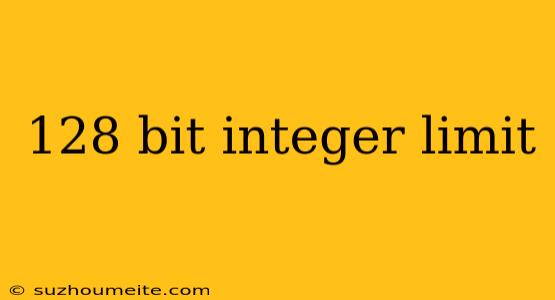The 128-bit Integer Limit: Understanding the Boundaries of Computer Arithmetic
Introduction
In computer arithmetic, integers are a fundamental data type used to represent whole numbers. However, integers have a limited range of values they can represent, and this range is determined by the number of bits used to store them. In this article, we will explore the 128-bit integer limit, its implications, and the consequences of exceeding this limit.
What is a 128-bit Integer?
A 128-bit integer is a numerical value represented using 128 bits of memory. This allows for a massive range of values, from 0 to 2^128 - 1, which is an enormously large number:
2^128 - 1 = 340,282,366,920,938,463,463,374,607,431,768,211,455
To put this number into perspective, the estimated number of atoms in the observable universe is on the order of 10^80. This means that a 128-bit integer can represent a value many orders of magnitude larger than the number of atoms in the universe.
Theoretical Limitations
While 128-bit integers can represent extremely large values, they are not without limitations. In theory, it is possible to exceed the 128-bit integer limit by performing arithmetic operations that produce a result larger than the maximum value that can be represented.
For example, consider the product of two large 128-bit integers:
a = 2^127 b = 2^127
The product of a and b would be:
a × b = 2^254
This result exceeds the maximum value that can be represented by a 128-bit integer, which is 2^128 - 1. This overflow would cause the result to wrap around to a smaller value, leading to incorrect calculations.
Practical Implications
In practice, the 128-bit integer limit has significant implications for various fields, including:
Cryptography
In cryptography, large integers are used to perform secure encryption and decryption. The 128-bit integer limit can compromise the security of certain cryptographic algorithms, making them vulnerable to attacks.
Scientific Computing
Scientific simulations and calculations often involve extremely large numbers. The 128-bit integer limit can restrict the accuracy and range of these calculations, leading to incorrect results.
Data Storage
Storing and processing large integers can be challenging due to the 128-bit limit. This can lead to increased storage requirements, slower processing times, and potential data loss.
Mitigating the Limitations
To mitigate the limitations of the 128-bit integer limit, various techniques can be employed:
Arbitrary-Precision Arithmetic
Arbitrary-precision arithmetic libraries, such as GNU Multiple Precision Arithmetic Library (GMP), allow for the representation of extremely large integers using multiple words of memory. This enables calculations to exceed the 128-bit limit.
Modular Arithmetic
Modular arithmetic, used in cryptography and other fields, involves performing calculations modulo a prime number. This reduces the range of values and mitigates the risk of overflow.
Distributed Computing
Distributed computing architectures can be used to parallelize calculations, allowing for the processing of large integers across multiple processors.
Conclusion
The 128-bit integer limit is a fundamental constraint in computer arithmetic, with significant implications for various fields. Understanding the limitations and consequences of exceeding this limit is crucial for developing efficient and accurate algorithms. By employing techniques such as arbitrary-precision arithmetic, modular arithmetic, and distributed computing, it is possible to mitigate the effects of the 128-bit integer limit and ensure the integrity of computations involving extremely large integers.
